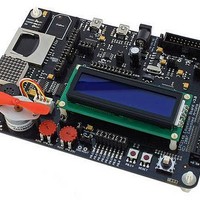EA-EDU-001 Embedded Artists, EA-EDU-001 Datasheet - Page 13

EA-EDU-001
Manufacturer Part Number
EA-EDU-001
Description
MCU, MPU & DSP Development Tools LPC2148 EDUCATION BRD
Manufacturer
Embedded Artists
Specifications of EA-EDU-001
Processor To Be Evaluated
LPC2148
Data Bus Width
16 bit, 32 bit
Interface Type
I2C, SPI, UART
Core
ARM7TDMI-S
Dimensions
156 mm x 110 mm
Maximum Operating Temperature
+ 85 C
Operating Supply Voltage
3.3 V
Lead Free Status / RoHS Status
Lead free / RoHS Compliant
NXP Semiconductors
6. Functional description
LPC2141_42_44_46_48_4
Product data sheet
6.1 Architectural overview
6.2 On-chip flash program memory
The ARM7TDMI-S is a general purpose 32-bit microprocessor, which offers high
performance and very low power consumption. The ARM architecture is based on
Reduced Instruction Set Computer (RISC) principles, and the instruction set and related
decode mechanism are much simpler than those of microprogrammed Complex
Instruction Set Computers (CISC). This simplicity results in a high instruction throughput
and impressive real-time interrupt response from a small and cost-effective processor
core.
Pipeline techniques are employed so that all parts of the processing and memory systems
can operate continuously. Typically, while one instruction is being executed, its successor
is being decoded, and a third instruction is being fetched from memory.
The ARM7TDMI-S processor also employs a unique architectural strategy known as
Thumb, which makes it ideally suited to high-volume applications with memory
restrictions, or applications where code density is an issue.
The key idea behind Thumb is that of a super-reduced instruction set. Essentially, the
ARM7TDMI-S processor has two instruction sets:
The Thumb set’s 16-bit instruction length allows it to approach twice the density of
standard ARM code while retaining most of the ARM’s performance advantage over a
traditional 16-bit processor using 16-bit registers. This is possible because Thumb code
operates on the same 32-bit register set as ARM code.
Thumb code is able to provide up to 65 % of the code size of ARM, and 160 % of the
performance of an equivalent ARM processor connected to a 16-bit memory system.
The particular flash implementation in the LPC2141/42/44/46/48 allows for full speed
execution also in ARM mode. It is recommended to program performance critical and
short code sections (such as interrupt service routines and DSP algorithms) in ARM
mode. The impact on the overall code size will be minimal but the speed can be increased
by 30 % over Thumb mode.
The LPC2141/42/44/46/48 incorporate a 32 kB, 64 kB, 128 kB, 256 kB and 512 kB flash
memory system respectively. This memory may be used for both code and data storage.
Programming of the flash memory may be accomplished in several ways. It may be
programmed In System via the serial port. The application program may also erase and/or
program the flash while the application is running, allowing a great degree of flexibility for
data storage field firmware upgrades, etc. Due to the architectural solution chosen for an
on-chip boot loader, flash memory available for user’s code on LPC2141/42/44/46/48 is
32 kB, 64 kB, 128 kB, 256 kB and 500 kB respectively.
The LPC2141/42/44/46/48 flash memory provides a minimum of 100000 erase/write
cycles and 20 years of data-retention.
•
•
The standard 32-bit ARM set.
A 16-bit Thumb set.
Rev. 04 — 17 November 2008
LPC2141/42/44/46/48
Single-chip 16-bit/32-bit microcontrollers
© NXP B.V. 2008. All rights reserved.
13 of 40



















